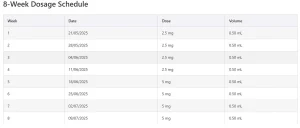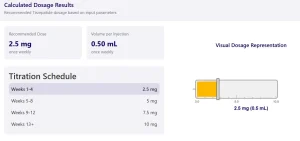Tirzepatide Dosage Calculator
Use this Tirzepatide Dosage Calculator to quickly estimate your personalized Tirzepatide dose based on your weight and treatment phase. This free calculator simplifies complex medical guidelines into an easy, actionable weekly dosage.
Patient Information & Dosage Parameters
Enter patient details and dosage requirements
Clinical Warning
Calculated Dosage Results
Recommended Tirzepatide dosage based on input parameters
Recommended Dose
2.5 mg
once weekly
Volume per Injection
0.5 mL
once weekly
Titration Schedule
Visual Dosage Representation
8-Week Dosage Schedule
| Week | Date | Dose | Volume | Dose per Injection | Volume per Injection |
|---|
Clinical Information
Tirzepatide (Mounjaro®) is a GIP/GLP-1 receptor agonist indicated for:
- Treatment of adults with type 2 diabetes mellitus
- Chronic weight management in adults with obesity or overweight with at least one weight-related comorbidity
Standard Titration: Start with 2.5 mg once weekly for 4 weeks, then increase to 5 mg once weekly. May increase to 7.5 mg and 10 mg once weekly if needed for glycemic control.
Extended Titration: For weight management, may continue titration to 12.5 mg and 15 mg once weekly if tolerated, with each dose increase occurring after 4 weeks.
Note: This calculator is intended as a clinical decision support tool. Always use professional judgment and refer to current prescribing information.
What is Tirzepatide?
Tirzepatide (marketed as Mounjaro®) is a first-in-class medication that combines dual GIP and GLP-1 receptor agonist activity. This unique mechanism of action offers superior glycemic control and notable weight reduction, making it a significant advancement in the management of type 2 diabetes and obesity.
Approved by the FDA in 2022, Tirzepatide is indicated for:
Glycemic management in adults with type 2 diabetes
Chronic weight management in adults with obesity (BMI ≥30) or overweight (BMI ≥27) with at least one weight-related comorbidity
The medication is administered once weekly via subcutaneous injection using a pre-filled pen.
Understanding Tirzepatide Dosing
Tirzepatide follows a structured titration schedule to reduce the risk of gastrointestinal side effects. The starting dose is 2.5 mg once weekly for the first 4 weeks.
For patients with type 2 diabetes, the dose increases by 2.5 mg every 4 weeks until the target maintenance dose (typically 5 mg, 7.5 mg, or 10 mg) is achieved.
For weight management, extended titration may be required, with dosing potentially reaching 12.5 mg or 15 mg once weekly.
Available dosage forms:
2.5 mg/0.5 mL
5 mg/0.5 mL
7.5 mg/0.5 mL
10 mg/0.5 mL
12.5 mg/0.5 mL
15 mg/0.5 mL
How to Use This Tirzepatide Calculator
Our Tirzepatide Dosage Calculator is a clinical support tool that simplifies dosing decisions and enhances patient education.
1. Enter Patient Information
Input weight in kg or lbs
Choose titration plan (standard or extended)
Enter current treatment week
Adjust frequency for split dosing if needed

2. Review the Results
View recommended dose in milligrams (mg)
See corresponding injection volume in milliliters (mL)
Visual syringe display for easier patient communication
Eight-week projection of future dosing steps


3. Customize When Needed
Toggle “Use Custom Dose” to override default titration
Select specific dosage from available options
Outputs adjust automatically to reflect changes
4. Save or Print
Use the “PDF” feature to create a printable dose plan
Share with patients to encourage adherence
Clinical Use Cases of Tirzepatide Calculator
Case 1: Initiating Therapy for Diabetes
Patient: Maria, 58 Scenario: Recently diagnosed with type 2 diabetes; A1C = 8.2%; on metformin Weight: 82 kg Plan: Standard titration up to 10 mg
Calculator Output: Recommends starting at 2.5 mg (0.5 mL) once weekly with full escalation timeline.
Case 2: Adjusting During Titration
Patient: John, 45 Scenario: On Tirzepatide for weight management; mild nausea at 5 mg Weight: 115 kg Plan: Extended titration to 15 mg Current Week: 6
Calculator Output: Confirms current dose of 5 mg weekly; provider chooses to extend at same dose using “Custom Dose.”
Case 3: Split Dosing for GI Tolerability
Patient: Susan, 62 Scenario: Significant nausea on 7.5 mg dose Plan: Split dosing
Calculator Output: Recommends 3.75 mg (0.25 mL) twice weekly to maintain total dose with improved tolerability.
Important Clinical Considerations
Always initiate treatment with 2.5 mg once weekly for the first 4 weeks
Increase doses only at 4-week intervals
Missed doses should be administered within 4 days; otherwise, skip and resume on the next scheduled day
Gastrointestinal side effects are common but often diminish over time
Monitor for hypoglycemia, particularly if used with insulin or sulfonylureas
Note: This calculator is intended as a clinical decision support tool. Always consult prescribing guidelines and apply professional judgment.
Frequently Asked Questions
Q: Can Tirzepatide be used with insulin?
A: Yes. Tirzepatide is compatible with basal insulin, but insulin dosages may need adjustment to prevent hypoglycemia.
Q: Does weight influence Tirzepatide dosage?
A: Tirzepatide dosing is not directly weight-based, but body weight is relevant for assessing treatment outcomes.
Q: What if a patient can’t tolerate higher doses?
A: Patients can remain on lower doses if well-tolerated. Extending the interval at a current dose before titrating further is also acceptable.
Q: Is Tirzepatide available as a generic?
A: No. Tirzepatide is only available as the brand-name product Mounjaro®.
Q: How should Tirzepatide pens be stored?
A: Store unopened pens in the refrigerator (36°F–46°F). After first use, pens may be kept at room temperature (below 86°F) for up to 21 days.
Q: Do you have a Tirzepatide Reconstitution Calculator?
A: Tirzepatide does NOT require reconstitution – it comes in solution form in pre-filled pens.
Reconstitution calculators are typically used for medications like certain antibiotics or biologics that come as powder and need to be mixed with a diluent.
Since Tirzepatide is already in solution form, a reconstitution calculator would not be relevant or necessary.
